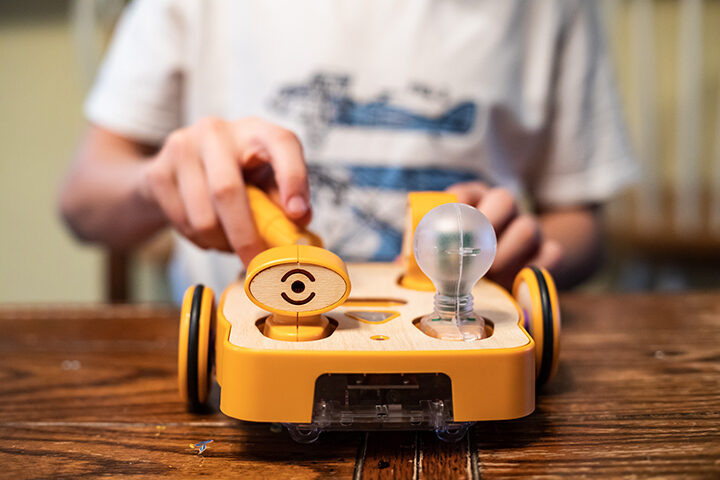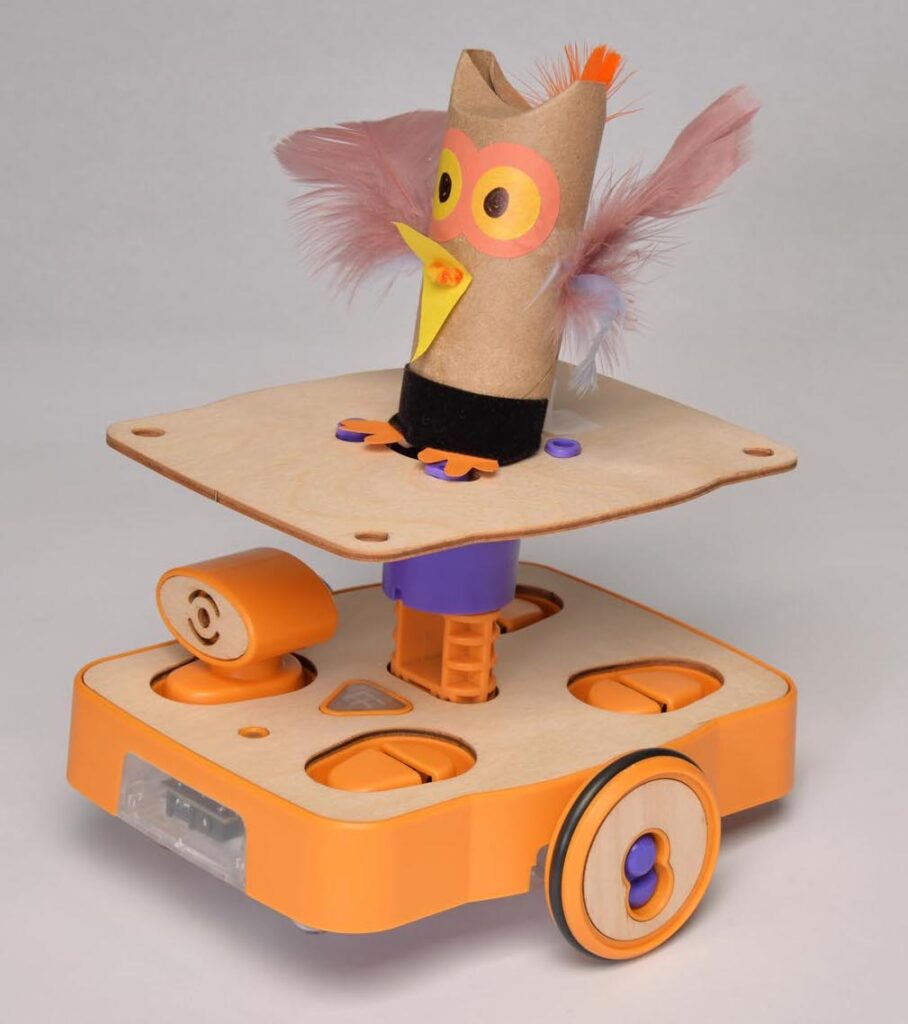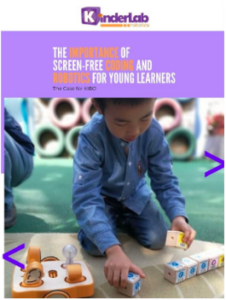AI Teaching Tips Using A Robot Coding Kit
In recent blog posts we’ve explored why young children should learn how AI works and what they should know about AI. So having explored the “why” and the “what”, let’s ask the practical question: “how?” How can we, as early childhood educators, make the advanced computer science and engineering concepts behind artificial intelligence accessible to young learners? The answer – as with so much effective educational practice for young learners – is constructivist, exploratory, hands-on activities with physical manipulatives, such as a robot coding kit.
What works best in early childhood works for AI education too
 Educational theorists – from Froebel and Montessori to Seymour Papert – have long recognized that children think and learn best when moving, playing, interacting with each other, and engaging with concrete objects. KinderLab’s co-founder Dr. Marina Bers extended this research into computer science education, proving that young children learn coding concepts better with physical manipulatives than abstract on-screen representations. Her findings guided the development of the screen-free KIBO Robot Coding Kit. With KIBO, children build their code by sequencing wooden blocks, and the programs they create affect the physical world – the robot moves and reacts based on the instructions the children give it. The robot is an “object to think with,” in Seymour Papert’s phrasing, allowing children to access abstract concepts through physical play.
Educational theorists – from Froebel and Montessori to Seymour Papert – have long recognized that children think and learn best when moving, playing, interacting with each other, and engaging with concrete objects. KinderLab’s co-founder Dr. Marina Bers extended this research into computer science education, proving that young children learn coding concepts better with physical manipulatives than abstract on-screen representations. Her findings guided the development of the screen-free KIBO Robot Coding Kit. With KIBO, children build their code by sequencing wooden blocks, and the programs they create affect the physical world – the robot moves and reacts based on the instructions the children give it. The robot is an “object to think with,” in Seymour Papert’s phrasing, allowing children to access abstract concepts through physical play.
Just as engaging with a physical robot is a research-proven way to teach young children about computer science, robotics also provides the perfect vehicle for teaching young children about artificial intelligence. Not only do we gain the educational benefits of concrete objects and manipulatives, we can also build on the many parallels between robotics concepts and AI concepts.
Sense-Think-Act: a “big idea” unifying AI and robot coding kits
Both AI and robots rely on the sense-think-act cycle we explored in a previous post. This cycle can guide us in how to make the fundamental “big ideas” of AI accessible to young children, with useful parallels at each stage of the cycle.
SENSE: Robots and AI both take in information about the world through sensors and input. Robots – including AI-enabled robots like self-driving cars – can “see” and “hear” like humans do, using sound sensors, motion sensors, and cameras. We can draw parallels for our students between robot sensors and human senses: just like we use our ears to hear each other’s words, a robot may use sound sensors to hear our spoken commands.
Activity Idea: Design hands-on activities where children experiment with simple sensors available in a robot coding kit like KIBO, then lead them in reflection about how the world would appear different to a robot with fewer, more, or different sensors than our own human senses.
THINK: Robots and AI both follow rules to decide how to act based on the information their sensors take in. These rules can be very complex, but they are built upon basic computational thinking concepts such as conditional logic (“if / then”) and abstraction (engaging with complex input by simplifying and categorizing).
 Activity Idea: Create simple games with playful robotics to present these ideas in concrete ways for young learners. A game like 20 Questions, or an activity where children come up with their own rules for sorting and grouping a diverse set of objects, can give practical experience with how robots and AI model the information the take in. And a robotics programming activity, where sensor input drives varying behavior – for example, a robot “owl” which is active when it’s dark but “sleeps” when it’s light – gives experience with the concept of processing sensor input.
Activity Idea: Create simple games with playful robotics to present these ideas in concrete ways for young learners. A game like 20 Questions, or an activity where children come up with their own rules for sorting and grouping a diverse set of objects, can give practical experience with how robots and AI model the information the take in. And a robotics programming activity, where sensor input drives varying behavior – for example, a robot “owl” which is active when it’s dark but “sleeps” when it’s light – gives experience with the concept of processing sensor input.
ACT: Once our AI system takes in and processes information, what should it do? The Act stage of the sense-think-act cycle is where our student engineers will play their most important role. One of the most important lessons of AI education in early childhood is that AI is a tool – and how that tool should be used is up to our students! They are the human engineers of the future who will decide what robots and AI will do and what positive impacts these systems will have.
Activity Idea: Engage with this big idea through a “helper robot” activity. Work with students to describe problems in their community, in their school, in their personal experiences; then using a robot coding kit like KIBO, design a “helper bot” that can act on its input to help people solve these problems. A pollution-cleanup robot that uses its distance sensor and motors to locate and gather trash? A rescue robot that uses its light-sensor and light bulb to illuminate dark places to find lost pets? Thinking about the practical and helpful role AI and robotic systems can play – and then actually building them with a developmentally appropriate robot coding kit like KIBO – helps students see that the positive impact of these systems is in their hands.
Explore AI with a simple robot coding kit
Even with advanced and abstract ideas like AI, we need to build on the aspects of early childhood education that we know work best: hands-on experience with physical manipulatives and playful opportunities for self-directed knowledge construction. Robot coding kits like KIBO provide a perfect – and research-proven – method to explore AI concepts in early childhood.
What do you think about the relevance of AI education in PK and early grades? Have you started to teach about AI? We’d love to hear your stories and opinions. Let us know on social at @KinderLabRobot, or just email me directly at jason@kinderlabrobotics.com!
-Jason Innes
Director of Curriculum, Training, and Product Management
Meet KIBO, the Screen-free Educational STEAM Robot Coding Kit
KIBO, the learning robot coding kit, designed specifically for elementary-aged kids, offers an inviting, engaging platform for young children to start their journey into creating with code in a fun and creative way. KIBO’s block-based coding language gives children control over the robot’s movements, sounds, and sensors, allowing them to express their imaginations with code. The KIBO curriculum for educators also teaches children to tell stories, create characters, and explore the world around them through code. KIBO is the number one choice in screen-free coding for kids – trusted by more parents and schools to introduce today’s youth to the wonders of technology and robotics.



















